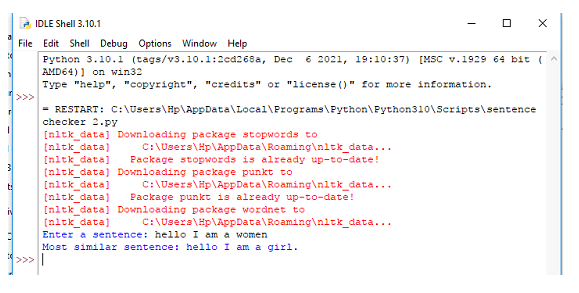
 Data Structure
Data Structure Networking
Networking RDBMS
RDBMS Operating System
Operating System Java
Java MS Excel
MS Excel iOS
iOS HTML
HTML CSS
CSS Android
Android Python
Python C Programming
C Programming C++
C++ C#
C# MongoDB
MongoDB MySQL
MySQL Javascript
Javascript PHP
PHP
- Selected Reading
- UPSC IAS Exams Notes
- Developer's Best Practices
- Questions and Answers
- Effective Resume Writing
- HR Interview Questions
- Computer Glossary
- Who is Who
Find the most Similar Sentence in the file to the Input Sentence | NLP
Natural Language Processing (NLP) allows computers to interpret and analyze human language. Finding the most identical word or sentence to a given input sentence is a prevalent NLP problem. In Python, there are various methods available to find identical sentences.
Required Resources
To get this done you have to install nltk library in your system. Therefore run the following command in your Python command prompt to install nltk.
pip install nltk
You may also run the following command in your Windows cmd if the above command fails to execute.
python --version pip --version pip install nltk
Once the library is successfully installed we can import it inside our code and use various modules from nltk to write a sentence finder program.
Example
We will create a Python program that takes input sentences from the user and finds the most similar sentence from a file. let's explore how to do this using the Python NLTK package. We will specifically use the TF-IDF (Term Frequency-Inverse Document Frequency) method and various NLP preprocessing steps.
Algorithm
Step 1: Install and Import NLTK. you can use any method explained above.
Step 2: Write code to load sentences from the file. Load the sentences and then produce them to generate a list of preprocessed sentences, each being stripped of any leading or following whitespace.
Step 3: Process the input sentence and stripped sentences of the file.
Step 4: Perform Tokenization to break each sentence into words.
Step 5: Remove stop words from sentences to compare the main words.
Step 6: Compare the words and assign them weight to find the words with the highest weight. Doing so you can find the most similar sentence in the file.
Example
import nltk
from nltk.corpus import stopwords
from nltk.tokenize import word_tokenize
from nltk.stem import WordNetLemmatizer
from sklearn.feature_extraction.text import TfidfVectorizer
# Download NLTK resources
nltk.download('stopwords')
nltk.download('punkt')
nltk.download('wordnet')
# Load the file containing sentences
def load_sentences(file_path):
with open(file_path, 'r') as file:
sentences = file.readlines()
return [sentence.strip() for sentence in sentences]
# Preprocess the input sentence
def preprocess_sentence(sentence):
# Tokenize
tokens = word_tokenize(sentence.lower())
# Remove stopwords
stop_words = set(stopwords.words('english'))
tokens = [token for token in tokens if token not in stop_words]
# Lemmatize
lemmatizer = WordNetLemmatizer()
tokens = [lemmatizer.lemmatize(token) for token in tokens]
return ' '.join(tokens)
# Get the most similar sentence
def get_most_similar_sentence(user_input, sentences):
# Preprocess input sentence
preprocessed_user_input = preprocess_sentence(user_input)
# Preprocess sentences
preprocessed_sentences = [preprocess_sentence(sentence) for sentence in
sentences]
# Create TF-IDF vectorizer
vectorizer = TfidfVectorizer()
# Generate TF-IDF matrix
tfidf_matrix = vectorizer.fit_transform([preprocessed_user_input] +
preprocessed_sentences)
# Calculate similarity scores
similarity_scores = (tfidf_matrix * tfidf_matrix.T).A[0][1:]
# Find the index of the most similar sentence
most_similar_index = similarity_scores.argmax()
most_similar_sentence = sentences[most_similar_index]
return most_similar_sentence
# Main program
def main():
file_path = 'sentences.txt' # Path to the file containing sentences
sentences = load_sentences(file_path)
user_input = 'hello I am a women'
most_similar_sentence = get_most_similar_sentence(user_input, sentences)
print('Most similar sentence:', most_similar_sentence)
if __name__ == '__main__':
main()
Text File Content : Sentences.txt
this is comedy movie.
this is horror movie.
hello I am a girl.
hello I am a boy.
Output

Conclusion
We have experienced the use of the NLTK library and NLP approaches to discover the sentence that is most similar to a given input text. We can efficiently compare sentences and find the closest match by using the TF-IDF method and preprocessing techniques like tokenization, stopword removal, and lemmatization.
You can use this approach in any application or program to add a sentence similarity check feature which can be used for relating useful information entered by the user.

